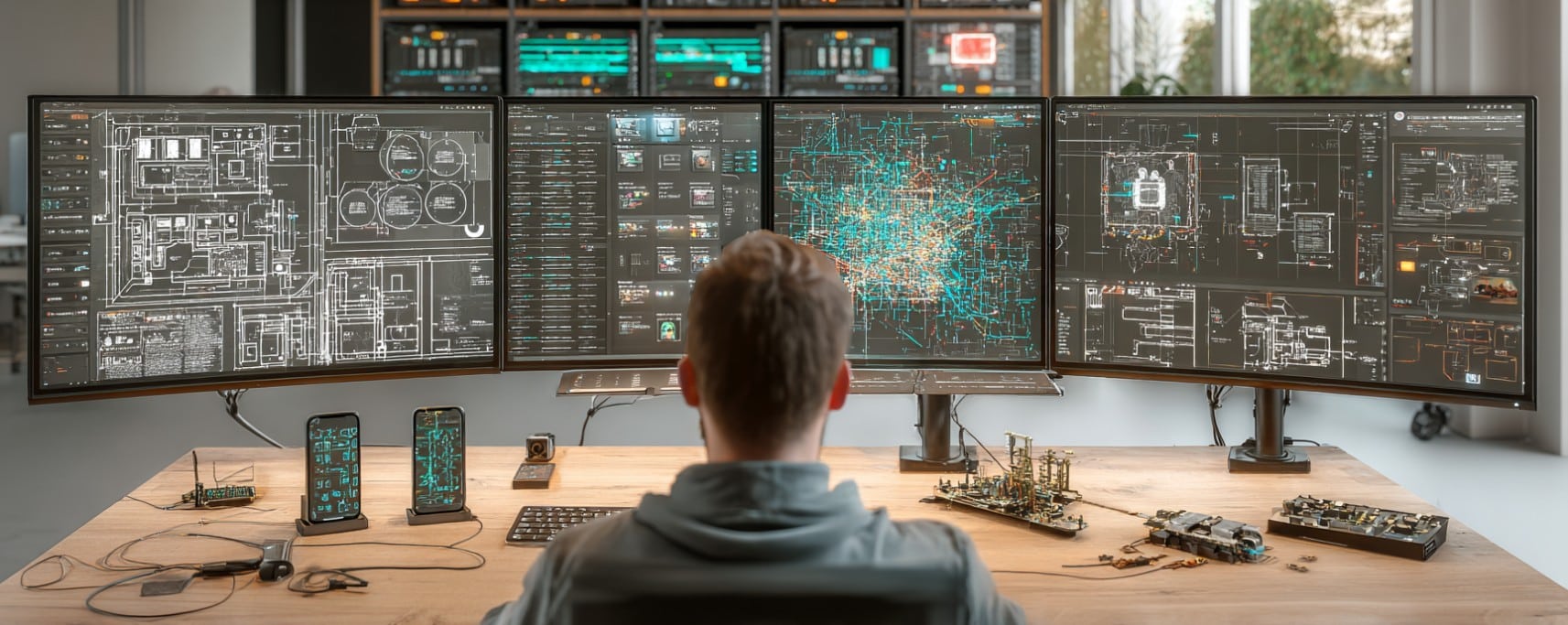
In the world of engineering, precision, accountability, and public safety are paramount. Whether you’re designing infrastructure, developing new technologies, or solving complex problems, the role of an engineer comes with immense responsibility. To uphold these high standards and ensure public trust, many engineers pursue Professional Engineer (PE) licensure, a distinguished certification that validates both technical expertise and ethical practice.
Earning your PE license not only grants you the legal authority to oversee and sign off on critical projects, but it also signifies your commitment to the highest professional standards. In an increasingly competitive and evolving field, holding a PE license can set you apart, offering enhanced career opportunities, greater earning potential, and the ability to make lasting contributions to society.
In this article, we’ll explore what Professional Licensure entails, why it’s essential for engineers, and how you can achieve this important milestone in your career.
What is Professional Licensure for Engineers?
Professional licensure for engineers, commonly known as becoming a Professional Engineer (PE), is a formal certification that demonstrates an engineer’s competency and adherence to a set of industry standards.
This licensure is recognized across the United States and in many countries globally, granting engineers the legal authority to sign off on public engineering projects, lead engineering teams, and take on leadership roles within the field.
The licensure process is governed by state or national boards, and each jurisdiction may have specific requirements, although the general process tends to follow a similar structure. For engineers working on public projects or those involving public safety, becoming a PE is not just beneficial—it is legally required.
Why is Becoming a Professional Engineer (PE) Important?
The importance of obtaining a Professional Engineer license extends far beyond legal requirements. Below are some key reasons why obtaining a PE licensure is critical for an engineer’s career and the field of engineering as a whole:
Demonstrating Competence and Credibility
Earning a PE license is a mark of distinction, signaling that an engineer has met rigorous education, experience, and examination requirements. This certification shows a commitment to the highest standards of professional practice and demonstrates a level of competence that is recognized by employers, peers, and clients.
Legal Authority to Sign Off on Projects
Only licensed Professional Engineers have the legal authority to sign, seal, and submit engineering drawings and calculations for public and private sector projects. This ensures accountability and guarantees that the work meets regulatory and safety standards.
Career Advancement
Many leadership roles, particularly those in government agencies, consulting firms, and large corporations, require a PE license. It opens the door to higher responsibility roles, project management, and decision-making positions that involve signing off on major projects.
Public Safety and Ethics
As a PE, an engineer is held to strict ethical standards. Professional Engineers are responsible for the safety, health, and welfare of the public. They are obligated to ensure that their designs and recommendations prioritize safety and are ethically sound.
Increased Earning Potential
On average, engineers with PE licenses tend to earn higher salaries than their non-licensed counterparts. The added responsibility and credibility often come with financial rewards, including promotions and the ability to start a private practice.
The Benefits of Being a Licensed Professional Engineer
Earning a Professional Engineer (PE) license offers significant benefits that go beyond meeting legal requirements. It is a mark of distinction in the field of engineering and provides numerous advantages:
- Professional Recognition: A PE license represents a high level of competence and ethical responsibility. Licensed engineers are often seen as leaders within their companies and industries, earning the respect of peers, employers, and clients.
- Greater Job Security: Licensed engineers are more likely to secure roles that involve public infrastructure, safety, or other critical projects. Many employers require a PE license for senior positions, ensuring you have more opportunities and long-term career stability.
- Entrepreneurial Opportunities: If you’ve ever thought about starting your own engineering consulting firm, a PE license is essential. It gives you the legal authority to independently sign off on engineering projects and submit plans to regulatory authorities, allowing you to take on contracts, lead projects, and grow your business.
- Higher Earning Potential: Engineers with a PE license often command higher salaries compared to those without it. The added responsibility, legal authority, and specialized expertise make licensed engineers more valuable to organizations, which translates to increased compensation.
How to Obtain a Professional Engineering License
The journey to becoming a licensed Professional Engineer typically involves several key steps, each designed to ensure that the engineer is well-equipped to handle the responsibilities that come with the title. Below is a detailed breakdown of the licensure process:
1. Earn a Degree from an ABET-Accredited Engineering Program
The first step in the path toward licensure is obtaining a degree in engineering from an institution accredited by the Accreditation Board for Engineering and Technology (ABET). This accreditation ensures that the program meets specific educational standards and prepares students for the licensure process.
- Why It Matters: ABET accreditation is a mark of quality. It ensures that your education includes the necessary technical skills, knowledge, and ethical grounding required to become a licensed engineer.
- What to Look For: Most undergraduate engineering programs, especially in fields like civil, mechanical, electrical, and chemical engineering, offer ABET-accredited degrees. Before selecting a school, ensure it has the accreditation.
2. Pass the Fundamentals of Engineering (FE) Exam
The next step is to pass the Fundamentals of Engineering (FE) exam, also known as the Engineer-in-Training (EIT) exam. This test is typically taken shortly after completing an undergraduate degree and is the first formal step toward becoming licensed.
- Exam Content: The FE exam covers a wide range of subjects, including mathematics, engineering ethics, and discipline-specific topics (mechanical, civil, electrical, etc.). It tests the basic technical knowledge that a graduate would have learned during their undergraduate studies.
- Timing: Most engineers take the FE exam immediately after graduation when the content is still fresh. However, it can also be taken later, depending on individual schedules and career paths.
- Why It’s Important: Passing the FE exam qualifies you as an Engineer-in-Training (EIT) or Engineering Intern (EI), signifying that you are on the path to licensure.
3. Gain Relevant Work Experience
After passing the FE exam, aspiring Professional Engineers must gain hands-on engineering experience under the supervision of a licensed PE. Most states require at least four years of relevant work experience before you can take the final licensing exam.
- What Qualifies as Relevant Experience: The work must be in a professional engineering environment where you apply your engineering knowledge to solve real-world problems. Supervisors must be licensed PEs who can verify and attest to your work experience.
- Why It’s Crucial: This period allows you to apply theoretical knowledge in practical settings, honing your skills in a supervised environment. You learn the ethical, legal, and professional responsibilities of the engineering profession.
4. Pass the Principles and Practice of Engineering (PE) Exam
Once you have gained the necessary work experience, the next step is to pass the Principles and Practice of Engineering (PE) exam. This is a rigorous, discipline-specific exam that tests your ability to practice competently in your chosen field.
- Exam Content: The PE exam is highly specialized. Engineers take an exam tailored to their specific discipline, such as civil, mechanical, electrical, or structural engineering.
- Preparation: This exam requires extensive preparation, as it tests both theoretical and applied engineering knowledge. Many engineers take preparatory courses or study intensively for several months.
- Why It’s the Final Step: Passing the PE exam signifies that you are fully qualified to practice as a licensed Professional Engineer, responsible for ensuring the safety, quality, and effectiveness of your engineering solutions.
5. Maintain Your PE License through Continuing Education
Once you have earned your PE license, the journey does not end there. Most states require licensed engineers to complete continuing education to maintain their license. This ensures that engineers stay up-to-date with the latest developments, technologies, and best practices in the field.
- What Counts as Continuing Education: Continuing education can include workshops, seminars, professional development courses, or even advanced degrees. The requirements vary by state.
- Why It’s Necessary: Engineering is an ever-evolving field, and continuing education ensures that licensed engineers remain knowledgeable about industry changes and innovations.
Licensure Requirements by Engineering Discipline
The process of becoming a licensed engineer is largely the same across different disciplines, but there are some nuances in the exams and experience required for each field:
- Civil Engineering: This is one of the most common fields for licensure due to the direct impact on public infrastructure and safety. The PE exam for civil engineers includes questions on construction, transportation, structural, and environmental engineering.
- Mechanical Engineering: Mechanical engineers often work on projects involving machinery, manufacturing processes, and systems design. The PE exam for this discipline focuses on mechanical systems, thermodynamics, and materials science.
- Electrical Engineering: Given the complexity of modern electrical systems, the PE exam for electrical engineers covers power systems, circuit analysis, and control systems. Electrical engineers often work in energy, telecommunications, or electronics industries, where licensure is important for public and industrial projects.
- Structural Engineering: Structural engineering licensure may require a separate, more specialized PE exam in addition to the civil engineering exam. This field involves designing buildings and structures to ensure they can withstand stresses and remain safe.
Licensure requirements may vary depending on the discipline’s specific public safety implications, so it’s important to choose the appropriate exam that aligns with your expertise.
State and Regional Variations in Licensure
While the general steps to becoming a PE are consistent, there are regional differences in licensure requirements and maintenance:
- Initial Licensure: In most states, engineers must pass the Fundamentals of Engineering (FE) exam and the Principles and Practice of Engineering (PE) exam, followed by gaining a specific amount of work experience under a licensed PE. However, some states have stricter or additional requirements, like specific coursework or extra work experience in a given field.
- Continuing Education Requirements: Many states require licensed engineers to complete continuing education (CE) credits to maintain their PE license. The number of hours and accepted forms of CE vary from state to state. For instance, California requires 30 hours of continuing education every two years, while Texas mandates 15 hours annually.
- License Renewal Periods: States also differ in their license renewal periods. In most states, PE licenses must be renewed every two years, but some, like New York, have a three-year renewal period.
Each state’s board of engineering provides detailed requirements, and it’s important to stay up-to-date with the specific regulations in your region.
Common Challenges in Becoming a PE (and How to Overcome Them)
Becoming a licensed PE is a rigorous process that presents a few challenges, but with the right strategies, you can overcome them:
- FE and PE Exam Preparation: The FE and PE exams are comprehensive and challenging. Engineers often struggle with the breadth of material covered, particularly if they’ve been out of school for several years. Solution: Invest in prep courses specifically tailored for the FE or PE exams. Online resources, practice exams, and refresher courses can help sharpen your knowledge and increase your chances of passing.
- Finding Relevant Work Experience: Gaining supervised work experience under a licensed PE can sometimes be a hurdle, particularly for those in smaller firms or industries where PEs are less common. Solution: Network within your field to find opportunities for mentorship with a licensed PE. Consider seeking positions at companies where PEs are required for projects, or look for internships or project-based work in public sector organizations.
- Balancing Exam Prep with Full-Time Work: Many engineers find it difficult to balance preparing for licensure exams with their professional and personal responsibilities. Solution: Create a structured study schedule that breaks down material into manageable sections, and consider study groups with peers to stay motivated and focused.
Maintaining Your Professional Engineer License
Once you’ve earned your PE license, you’ll need to maintain it through continuing education (CE) and license renewal processes. Here’s what you should know:
- Continuing Education (CE): To stay current with industry developments, licensed engineers are often required to complete CE credits, which can include attending workshops, seminars, or online courses. Topics often include ethics, new technologies, regulatory updates, and advanced engineering principles.
- Tracking Your CE Credits: Most state boards require you to report your completed CE credits during the license renewal process. Keeping an organized record of the courses you’ve taken and the credits earned is essential to streamline your renewal.
- Renewal Periods: As mentioned earlier, the renewal periods and CE requirements differ by state. Make sure to keep track of your license’s expiration date and any deadlines for submitting your CE documentation.
Maintaining your PE license not only ensures compliance but also keeps you up-to-date with industry standards and technological advancements, allowing you to stay competitive in your field.
International Licensure and Global Mobility
In today’s globalized world, engineers are often involved in projects across borders. While the PE license is recognized in the U.S., international work may require additional steps:
- Recognition of U.S. PE License Abroad: Certain countries recognize U.S. PE licenses, particularly those that participate in the Washington Accord, an international agreement for accrediting engineering degree programs. Countries like Canada, Australia, and the United Kingdom have agreements to facilitate mutual recognition of licensure qualifications.
- Licensing in Other Countries: If you plan to work abroad, you may need to apply for licensure in the country where you’ll be practicing. This can involve proving your credentials, passing local exams, or meeting specific work experience requirements. Solution: Research the licensing body in your target country early in the process to understand their specific requirements.
- International Engineering Organizations: Associations such as the International Engineering Alliance (IEA) work to facilitate the mobility of professional engineers across borders. By connecting with global networks, you can stay informed about international licensure standards and collaborate with engineers from other regions.
Conclusion: The Value of Being a Licensed Professional Engineer
Obtaining a Professional Engineer license is a major milestone in an engineer’s career. It not only provides the legal authority to sign off on projects but also serves as a mark of credibility, ethical responsibility, and technical competence.
For engineers committed to advancing their careers, making a tangible impact, and gaining recognition in the field, pursuing licensure is a valuable step. Whether you’re focused on public infrastructure, high-tech industries, or cutting-edge innovations, a PE license ensures that you are recognized as a leader and trusted expert in your profession.
In summary, while the path to licensure is challenging and requires dedication, the rewards are significant. From enhanced career opportunities to increased earning potential and the ability to lead projects that shape society, becoming a Professional Engineer is a goal worth pursuing.



